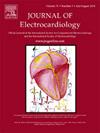Electrocardiographic changes associated with SSRI use: Insights from a cross-sectional study in Fasa Adults Cohort Study (FACS)
IF 1.3
4区 医学
Q3 CARDIAC & CARDIOVASCULAR SYSTEMS
引用次数: 0
Abstract
Background
Serotonin reuptake inhibitors (SSRIs), commonly prescribed for psychiatric disorders, have raised concerns about potential cardiovascular effects. Investigating their influence on specific electrocardiogram (ECG) parameters is crucial for a detailed clinical understanding.
Methods
This cross-sectional study, that utilizes data from the Fasa Adult Cohort Study in Iran, examined 133 individuals on SSRIs. We focused on participants without existing heart conditions, collecting drug details and daily doses through an online survey. ECG recordings that were analyzed by Cardiax® 28 provided insights into various parameters. Statistical analyses, including Mann-Whitney U and linear regression, assessed connections between SSRIs and ECG changes. Ethical approval was obtained for study validity.
Results
Among 133 participants, including citalopram (n = 38), fluoxetine (n = 63), and sertraline (n = 32) groups, this study revealed distinctive electrocardiogram (ECG) changes linked to selective serotonin reuptake inhibitor (SSRI) usage. Significant correlations between SSRIs, and various ECG parameters, with the exception of P duration, were discernible. SSRIs suggested negative correlations with HR, PR, QTC, QRS-axis, RdV5, Sd v2, and reductions in STJ V2, STJ V5, STM V2, STM V5, STE V2, and STE V5 (p < 0.01 or p < 0.05). Positive correlations were observed for QRS, QT, P-axis, and P a2 (p < 0.01 or p < 0.05), highlighting the complicated impact of SSRIs on cardiac electrophysiology.
Conclusion
In conclusion, careful monitoring of ECG parameters during SSRIs treatment is essential, especially in patients with pre-existing cardiac conditions. The observed associations highlight the need for personalized medical guidance when prescribing SSRIs. These findings provide valuable insights into the current medical knowledge, highlighting the need for additional research to completely understand the intricate link between SSRIs and cardiovascular health and to ensure the best possible patient safety. The limitations of this study included the possibility of errors in completing the questionnaires and their incompleteness, lake of baseline ECG which resulted in a decreased number of available cases.
与服用 SSRI 相关的心电图变化:法萨成人队列研究(FACS)横断面研究的启示
背景羟色胺再摄取抑制剂(SSRIs)是治疗精神疾病的常用处方药,它对心血管的潜在影响引起了人们的关注。调查它们对特定心电图(ECG)参数的影响对于详细了解临床情况至关重要。方法这项横断面研究利用伊朗法萨成人队列研究(Fasa Adult Cohort Study)的数据,对 133 名服用 SSRIs 的患者进行了调查。我们重点研究了无心脏疾病的参与者,通过在线调查收集了药物详情和每日剂量。由 Cardiax® 28 分析的心电图记录提供了对各种参数的深入了解。包括曼-惠特尼 U 和线性回归在内的统计分析评估了 SSRI 与心电图变化之间的联系。结果在 133 名参与者中,包括西酞普兰组(38 人)、氟西汀组(63 人)和舍曲林组(32 人),本研究揭示了与使用选择性血清素再摄取抑制剂(SSRI)相关的独特心电图(ECG)变化。除 P 持续时间外,SSRI 与各种心电图参数之间存在明显的相关性。SSRI 与心率、PR、QTC、QRS 轴、RdV5、Sd v2 呈负相关,与 STJ V2、STJ V5、STM V2、STM V5、STE V2 和 STE V5 的减少呈正相关(p < 0.01 或 p < 0.05)。QRS、QT、P 轴和 P a2 呈正相关(p < 0.01 或 p < 0.05),凸显了 SSRIs 对心脏电生理学的复杂影响。观察到的关联突出表明,在处方 SSRIs 时需要个性化的医疗指导。这些发现为当前的医学知识提供了宝贵的见解,强调了进行更多研究的必要性,以全面了解 SSRIs 与心血管健康之间错综复杂的联系,并确保患者的最佳安全。本研究的局限性包括问卷填写可能存在错误和不完整,基线心电图湖导致可用病例数量减少。
本文章由计算机程序翻译,如有差异,请以英文原文为准。
求助全文
约1分钟内获得全文
求助全文
来源期刊

Journal of electrocardiology
医学-心血管系统
CiteScore
2.70
自引率
7.70%
发文量
152
审稿时长
38 days
期刊介绍:
The Journal of Electrocardiology is devoted exclusively to clinical and experimental studies of the electrical activities of the heart. It seeks to contribute significantly to the accuracy of diagnosis and prognosis and the effective treatment, prevention, or delay of heart disease. Editorial contents include electrocardiography, vectorcardiography, arrhythmias, membrane action potential, cardiac pacing, monitoring defibrillation, instrumentation, drug effects, and computer applications.
 求助内容:
求助内容: 应助结果提醒方式:
应助结果提醒方式:


